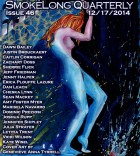So last week I kept a copy of “Exterminator” folded in a pocket of my jeans and pulled it out to hand to people at random moments, like some sort of Ancient Mariner. It’s an extremely concise story, around 300 words, so it was very portable. How did this story come into being for you—and did you realize from the beginning of composition that it would be a very short one, rendered in a single sentence?
Thank you for Ancient Mariner-ing my story. I wish more people would share flash fiction that way. This piece came from a workshop assignment where I had to write a one-sentence story of 250–300 words. So I knew the parameters before even figuring out what the story was. And it needed to be an urgent situation in order to justify the use of a single sentence. What came to mind was a family anecdote where my uncle kept a snake in his closet . . . I must have heard this story since I was born. I never even considered that it could be my story to tell until now, and it seemed like the right time to tell it.
What I admire most isn’t really the technical tour de force the story represents (which is a bonus), but the subtlety with which it conveys its emotional effects by the end. The narrator pulls us toward him by the strength of his voice. What was behind the decision to convey the story via a charming voice attached to a character who is, in the end, poignantly clueless?
It has to do with reliability. I guess I was afraid that the father could come off as more authoritative if he had an elevated, clean voice. But when he’s narrating in this raw vernacular, his cluelessness can slap a reader in the face. The entire language of the piece is now warped toward his own personality, preferences, biases, mood, etc.—and that warps the rest of the story with it. Plus, it’s a quick way to paint a character without taking up too much space.
Your use of objects—concrete detail—is very smart in “Exterminator” and the reader has a vivid visual sense of the fictional reality throughout the story. I’d like you to discuss just one of the objects, perhaps my favorite because of its devastating triviality: the eggplant. Tell us about that vegetable and its placement in the piece. OK, I lied . . . please talk about the role of concrete detail here in general.
Adhering to the single-sentence structure, I couldn’t have clauses snowballing into each other without relying on concrete details. Let’s say the action is interrupted by abstract details, like an internal monologue, or habitual details, like flashback exposition. When we come back to the present action, all the tension is then lost. By keeping everything anchored in concrete detail, the moment never fades. We’re living through the danger only until it subsides, until the snake’s down the stairs.
And eggplant’s a bitch to grow. That’s the real tragedy here.
We’re all excited here that this is your first published story. I find it hard to believe, frankly. Can you tell us more about yourself—why and how you started writing, where you’re from, whose work you like to read, what your current and future writing projects are?
I’m honored to have my work up there alongside writers like Stuart Dybek, Steve Almond, and Mike Meginnis. They’ve all shaped my writing quite a bit. So, thank you for sharing the excitement.
A little about me: I grew up in Long Island and moved to Boston to study film at Emerson College. Somewhere down the line, I realized I wasn’t too passionate about filmmaking. Eternal group work was never my strong suit. (Neither was waiting all day for Final Cut Pro to render.) But I did love the creative freedom of storytelling, so I took a shot at a few short-fiction workshops. Now I’m still at Emerson, six years later, working on a short-story collection for my MFA project. I can’t see the future past that. And I’m currently enjoying James Salter, Steven Millhauser, and Alice Munro.



 The core workshop of SmokeLong Fitness is all in writing, so you can take part from anywhere at anytime. We are excited about creating a supportive, consistent and structured environment for flash writers to work on their craft in a community. We are thrilled and proud to say that our workshop participants have won, placed, or been listed in every major flash competition. Community works.
The core workshop of SmokeLong Fitness is all in writing, so you can take part from anywhere at anytime. We are excited about creating a supportive, consistent and structured environment for flash writers to work on their craft in a community. We are thrilled and proud to say that our workshop participants have won, placed, or been listed in every major flash competition. Community works.